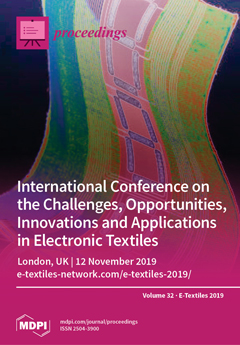Need Help?
Proceedings, 2019, E-Textiles 2019
International Conference on the Challenges, Opportunities, Innovations and Applications in Electronic Textiles
London, UK | 12 November 2019
Volume Editors:
Steve Beeby, University of Southampton, UK
Kai Yang, University of Southampton, UK
- Issues are regarded as officially published after their release is announced to the table of contents alert mailing list.
- You may sign up for e-mail alerts to receive table of contents of newly released issues.
- PDF is the official format for papers published in both, html and pdf forms. To view the papers in pdf format, click on the "PDF Full-text" link, and use the free Adobe Reader to open them.
Cover Story (view full-size image):
The E-Textiles Network is an Engineering and Physical Sciences Research Council (EPSRC)-funded activity to bring together researchers and developers from academia and industry interested in adding
[...] Read more.
The E-Textiles Network is an Engineering and Physical Sciences Research Council (EPSRC)-funded activity to bring together researchers and developers from academia and industry interested in adding electronic functionality to textiles and their related products. E-textiles offer a new class of products across a range of applications, including medical, performance sports, automotive, and fashion. E-Textiles 2019: International Conference on the Challenges, Opportunities, Innovations and Applications in Electronic Textiles is the first conference to be held by the E-Textiles Network and covers topics including textile power supplies, textile sensors and actuators, manufacturing, and materials and applications of e-textiles. This collection includes abstracts of works that were presented at the conference on 12 November 2019 in London.
Previous Issue
Next Issue
Issue View Metrics
Multiple requests from the same IP address are counted as one view.



